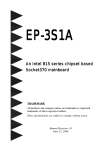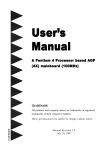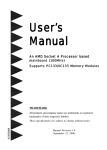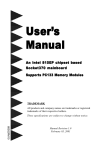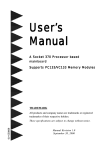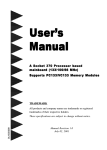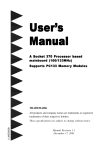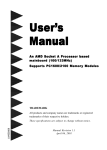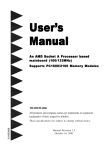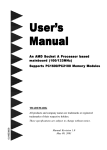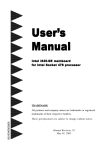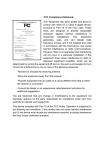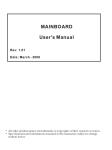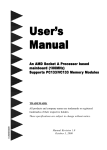Download User`s Manual
Transcript
User’s
Manual
An Intel 815EP chipset based
d
Sock
mainboard
Soc
ket370 mainboar
TRADEMARK
All products and company names are trademarks or registered
trademarks of their respective holders.
These specifications are subject to change without notice.
60002SL11
Manual Revision 1.1
February 06, 2001
Table of Contents
Page
Section 1
Introduction
Components Checklist ................................................... 1-1
Overview
Intel Celeron processors (P.P.G.A.) 370 ...................... 1-2
Intel Coppermine processors (FC-PGA) 370 ............... 1-3
Intel® 815EP Chipset Feature ........................................ 1-4
Accelerated Graphics Port ............................................. 1-5
Ultra ATA/66/100 ............................................................ 1-5
Hardware Monitoring ..................................................... 1-5
Mainboard Form-Factor ................................................. 1-6
I/O Shield Connector ...................................................... 1-7
Power-On/Off (Remote) ................................................ 1-7
System Block Diagram ................................................... 1-8
Section 2
Features
Mainboard Features ........................................................ 2-1
Section 3
Installation
Mainboard Detailed Layout ............................................ 3-2
Easy Installation Procedure
CPU Insertion ................................................................. 3-3
Jumper Settings ............................................................... 3-5
System Memory Configuration ...................................... 3-6
Device Connectors ......................................................... 3-8
External Modem Ring-in Power ON and
Keyboard Power ON Function (KBPO) ........................ 3-12
STR (Suspend To RAM) Function .................................. 3-14
“POSTMAN” Function Introduction (Optional) ............. 3-16
Section 4
Award BIOS Setup
Main Menu ...................................................................... 4-1
Standard CMOS Setup .................................................... 4-3
Advanced BIOS Features ................................................ 4-7
Advanced Chipset Features ............................................ 4-10
Integrated Peripherals ..................................................... 4-13
Power Management Setup .............................................. 4-18
PNP/PCI Configuration Setup ........................................ 4-21
PC Health Status ............................................................. 4-22
Frequency Control .......................................................... 4-24
Defaults Menu ................................................................. 4-25
Supervisor/User Password Setting ................................. 4-26
Exit Selecting .................................................................. 4-27
Section 5
815EP Driver Installation
Easy Driver Installation .................................................. 5-1
Appendix
Appendix A
Load Optimized Defaults ................................................ A-1
Appendix B
GHOST 5.1 Quick User’s Guide .................................... B-1
Introduction
Section 1
INTRODUCTION
Components Checklist
9
A. (1)
Mainboard
9
B. (1)
User’s manual
9
C. (1)
Floppy ribbon cable
9
D. (1)
ATA66/100 Hard drive ribbon cable
9
E. (1)
USB cable
9
F. (1)
Driver and Utility
9
G. (1)
ATA33 Hard drive ribbon cable
USER’S
MANUAL
C
D
B
A
G
or
E
F
Page 1-1
Introduction
Overview
Intel Celeron processors (P.P.G.A.) 370
The Intel Celeron processors provide power to handle the internet, educational
programs, interactive 3D games, and productivity applications. The Intel Celeron
processors at 766, 733, 700, 667, 633, 600, 566, 533MHz include integrated L2
cache 128Kbyte. The core for the 766, 733, 700, 667, 633, 600, 566, 533MHz
processors have 19M transistors due to the addition of the integrated L2 cache
128Kbyte. All the Intel Celeron processors are available in the plastic pin grid array
(P.P.G.A.) form factor. The P.P.G.A. form factor is compatible with the 370 pin
socket. All the Intel Celeron processors are available in the plastic pin grid array
(PPGA) package. The PPGA package is compatible with the 370 pin socket and
provides more flexibility to design low cost systems by enabling lower profile and
smaller systems and providing the potential for reducing costs of processor retention and cooling solutions. Like the Intel Celeron processors that utilize S.E.P.P.,
the Intel Celeron processors that use P.P.G.A., feature a P6-microarchitecture-based
core processor on a single-sided substrate without BSRAM componentry.
The Intel Celeron processor at 766, 733, 700, 667, 633, 600, 566, 533MHz. Includes Intel MMX[tm] media enhancement technology. Offers Dynamic Execution
technology.
Includes a 32Kbyte (16Kbyte/16Kbyte) non-blocking, level-one cache that provides
fast access to heavily used data. Intel Celeron processors at 766, 733, 700, 667,
633, 600, 566, 533MHz include integrated L2 cache 128Kbyte. All the Intel Celeron
processor utilize the Intel P6 microarchitecture’s multi-transaction system bus at
66MHz. The 766, 733, 700, 667, 633, 600, 566, 533MHz processors utilize the
Intel P6 microarchitecture’s multi-transaction system bus with the addition of the
L2 cache interface. The combination of the L2 cache bus and the processor-tomain-memory system bus increases bandwidth and performance over single-bus
processors.
Intel MMX technology includes new instructions and data types that allow
applications to achieve a new level of performance. Intel’s MMX technology is
Page 1-2
Introduction
designed as a set of basic, general-purpose integer instructions that are easily
applied to the needs of a wide diversity of multimedia and communications
applications. The highlights of the technology are:
* Single Instruction, Multiple Data (SIMD) technique
* 57 new instructions
* Eight 64-bit wide MMX technology registers
* Four new data types
Intel Coppermine processors (FC-PGA) 370
These Coppermine-128K and Coppermine-256K processor is the next addition to the
P6 micro architecture product family. The FC-PGA package is a new addition to the
Intel IA-32 processor line and hereafter will be referred to as the “Coppermine FCPGA processor”, or simply “The processor”. The package utilizes the same 370-pin
zero insertion force socket (PGA370) used by the Intel Celeron processor. Thermal
solutions are attached directly to the back of the processor core package without the
use of a thermal plate or heat spreader.
The Coppermine processor, like the Intel Celeron, Intel Pentium II and Pentium III in
the P6 family processor, implement a Dynamic Execution micro architecture --- a unique
combination of multiple branch prediction, data flow analysis, and speculative
execution. This enable these processors to deliver higher performance than the Intel
Pentium processor, while maintaining binary compatibility with all previous Intel Architecture processors. The processor also executes Intel MMX technology instructions for enhanced media and communication performance just as it’s predecessor the
Intel Pentium III processor. Additionally the Coppermine FC-PGA processor executes
streaming SIMD (Single-Instruction Multiple Data) Extensions for enhanced floating
point and 3-D application performance. The concept of processor identification, via
CPUID, is extended in the processor family with the addition of a processor serial
number. The processor utilizes multiple low-power states such as AutoHALT, StopGrant, Sleep and Deep Sleep to conserve power during idle times.
The processor includes an integrated on-die, 128KB or 256KB, 8-way set associative level-two (L2) cache with a separated 16KB level one (L1) instruction cache
Page 1-3
Introduction
and 16KB level one (L1) data cache. These cache arrays run at the full speed of the
processor core. As with the Intel Pentium III processor, the Coppermine FC-PGA
processor has a dedicated L2 cache bus, thus maintaining the dual independent bus
architecture to deliver high bus bandwidth and performance. Memory is cacheable
for 4GB/64GB of addressable memory space, allowing significant headroom for
desktop system.
Intel(R) 815EP chipset features
The Intel(R) 815EP chipset that SDRAM interface supports 100MHz and
133MHz operation, the Intel(R) 815EP chipset has re-engineered the Value PC,
providing next generation features and great graphics performance.
The Intel(R) 82815EP provides an AGP universal connector to support the AGP
2.0 including 4X AGP data transfers.
The 82801BA I/O Controller Hub (ICH2) employs the Intel(R) Accelerated Hub
Architecture to make a direct connection from the graphics and memory to the
integrated AC97 controller, the IDE controllers (ATA/66 or ATA/33 or ATA/100),
dual USB ports, and PCI add-in cards.
The Accelerated Hub Architecture provides twice the bandwidth of the PCI bus at
266 MB per second. This allows a wider flow of rich information from the I/O
controller to the memory controller, with optimized arbitration rules allowing
more functions to run concurrently, enabling more life-like audio and video.
The Integrated Audio-Codec 97 controller enables software audio by using the
processor to run sound. By reusing existing system resources, this feature adds
flexibility, improves sound and modem quality.
The 82802 Firmware Hub (FWH, 2MB) stores system BIOS and video BIOS,
eliminating a redundant nonvolatile memory component. In addition, the 82802
contains a hardware Random Number Generator (RNG). The Intel(R) RNG
provides truly random numbers to enable fundamental security building blocks
supporting stronger encryption, digital signing, and security protocols for the
future application program .
Page 1-4
Introduction
Accelerated Graphics Port
(AGP or A.G.P.)
Typically, 3D graphics rendering requires a tremendous amount of memory, and
demands ever increasing throughput speed as well. As 3D products for the
personal computer become more and more popular, these demands will only
increase. This will cause a rise in costs for both end users and manufacturers.
Lowering these costs as well as improving performance is the primary motivation
behind AGP. By providing a massive increase in the bandwidth available between
the video card and the processor, it will assist in relieving some of these pressures
for quite sometime.
The board provides the AGP 2.0 interface. The AGP Interface Specification
revision 2.0 enhances the functionality of the original AGP Interface Specification (revision 1.0) by allowing 4X data transfers (4 data samples per clock) and 1.
5 volt (power supply) operation. The AGP 2.0 interface, along with Direct
Rambus memory technology, allows graphics controllers to access main memory
at over 1GB/s. In order to match the 1X, 2X and 4X AGP Card. The board used
the Universal AGP connector. To maximize add-in flexibility. (such as 1.5 volt
for 1X, 2X and 4X or 3.3 volt for 1X and 2X AGP Card).
Ultra ATA/66/100
The ICH2 provides two channel Ultra ATA/66/100 Bus Master IDE controller, that
support Ultra ATA/66/100 protocols, perfect for such demanding applications as
real-time video, multimedia, and high performance operating system. A new IDE
cable is required for Ultra ATA/66/100. This cable is an 80 conductor cable;
however the connectors are, of course, backwards compatible with ATA/33.
Hardware Monitoring
Hardware monitoring allows you to monitor various aspects of your systems
operations and status. The features include CPU temperature, voltage and RPM of
fan.
Page 1-5
Introduction
Mainboard Form-Factor
The board is designed with ATX form factor - the new industry standard of
chassis. The ATX form factor is essentially a Baby-AT baseboard rotated 90
degrees within the chassis enclosure and a new mounting configuration for the
power supply. With these changes the processor is relocated away from the
expansion slots, allowing them all to hold full length add-in cards. ATX defines a
double height aperture to the rear of the chassis which can be used to host a wide
range of onboard I/O. Only the size and position of this aperture is defined,
allowing PC manufacturers to add new I/O features (e.g.; TV input, TV output,
modem, LAN, etc.) to systems. This will help systems integrators differentiate
their products in the marketplace, and better meet your needs.
•
Smaller size promotes a smaller system size.
•
I/O shield does not need to be retooled in an ATX 2.01 or later. Mainboard
could be used in an ATX 2.01-compliant.
•
A smaller power supply cam be used. High integration on mainboard reduces
the system costs.
Expandable I/O
Single chassis
fan for system
AT X
Power
Supply
PCI slots
ATX power
connector
AGP slots
Floppy / IDE
connectors
CPU
3 1/2"
Bay
5 1/4"
Bay
Figure 2: Summary of ATX chassis features
Page 1-6
Introduction
I/O Shield Connector
The board is equipped with an I/O back panel. Please use the appropriate I/O
shield (figure 3).
Joystic/Midi port
parallel port
PS/2 Mouse
USB port
PS/2
KEYBOARD
COM1
COM2 Speaker
Line_in
MIC
Figure 3: I/O back panel layout
Power-On/Off (Remote)
The board has a single 20-pin connector for ATX power supplies. For ATX power
supplies that support the Remote On/Off feature, this should be connected to the
systems front panel for system Power On/Off button. The systems power On/Off
button should be a momentary button that is normally open.
The board has been designed with “Soft Off" functions. You can turn Off the
system from one of two sources: The first is the front panel Power On/Off the
button, and the other is the "Soft Off" function (coming from the M/B’s onboard
circuit controller) that can be controlled by the operating system such as Windows® 95/98 or Windows® 2000.
ATX
POWER SUPPLY
J3
Case (chassis) Power
ON/OFF button
Figure 4: Simple ATX Power
ON/OFF Controller
Page 1-7
Introduction
System Block Diagram
Figure 5: System Block Diagram
Page 1-8
Features
Section 2
FEATURES
Mainboard Features:
•
The board is based on the Socket 370 Processors including PPGA & FC-PGA
operating at 433 ~933MHz. The board is configured by a BIOS setting to
match your CPU clock speed.
•
The board designed with Intel 815EP chipset that provides optimized
support for P.P.G.A Celeron of 66MHz and FC-PGA Coppermine of 100/
133MHz Front Side Bus CPU.
•
Supports AGP universal connector support via dual mode buffers to allow
AGP 2.0 3.3V (2X AGP) or 1.5V (4X AGP) signaling.
•
Supports up to 512 MB of DRAM (minimum of 32 MB) on board, You
can use 168-pin DIMM x 3. It will run Synchronous DRAM memory
(SDRAM) at 100MHz/133MHz.
•
AC’97 2.1 Audio CODEC onboard for enables the software Audio.
•
Supports (5) 32 bit PCI slots, provides (2) independent high performance
PCI IDE interfaces capable of supporting PIO Mode 3/4 and Ultra DMA
66/100 devices. The board supports (5) PCI Bus Master slots and a
jumperless PCI INT# control scheme which reduces configuration confusion when plugging in PCI card(s).
•
Supports ATAPI (e.g. CD-ROM) devices on both Primary and Secondary
IDE interfaces.
•
Designed with Winbond W83627HF LPC (Low Pin Count) I/O: (1) floppy
port, (1) parallel port (EPP, ECP), (2) serial ports (16550 Fast UART),
IrDA version SIR protocol or SHARP ASK-IR protocol, (1) Game port and
MIDI port.
•
Includes PS/2 mouse and keyboard connectors.
•
Features Award Plug & Play BIOS. With 2MB(FWH) Flash Memory you can
always upgrade to the current BIOS.
Page 2-1
Features
•
Utilizes a Lithium battery which provides environmental protection and
longer battery life.
•
The onboard ICH2(82801BA) chip provides the means for connecting PC
Interface and peripherals such as; PCI Bus I/F, LPC I/F, SM Bus, IDE and
USB.
•
Supports up to 4 USB ports, two on the back panel and two for front or
USB cable (optional), for more peripheral connectivity options.
•
Built-in ATX 20-pin power supply connector.
•
Software power-down when using Windows® 95/98 or Windows® 2000.
•
Supports ring-in feature (remote power-on through external modem, allow
system to be turned on remotely).
•
Resume by Alarm - Allow your system to turn on according to setup
schedule in the BIOS.
•
Supports CPU & Hardware sleep and SMM (System Management Mode).
•
Supports Hot key, Any key or password Keyboard power ON function
(KBPO).
•
Supports the CPU, Power and Chassis fan Auto stop in the sleep mode.
•
Supports the System Power LED (PANEL) blinks in the sleep mode.
•
Built-in WOL (Wake On Lan) Connector.
•
Y2K Compliant.
•
Advanced Configuration Power Interface (ACPI) ready.
•
Supports USDM software to offer motherboard various status on Windows®
95/98.
•
Supports the STR (Suspend To RAM) power management by ACPI’s S3.
•
Supports the STR indicator red LED (D5) to avoid pluging or un-pluging
DIMM modules when in a STR mode or power on mode.
•
Supports a CNR Connector for V9.0 analog modem, phone-line base and 10/
100 Ethernet base networking.
•
Supports a “POSTMAN” function to deliver a easy way for the Power On Self
Test (POST) sending out a error messages via huMANlike voice (Optional).
Page 2-2
Installation
Section 3
INSTALLATION
Mainboard Detailed Layout
Figure 1
Page 3-1
Installation
Easy Installation Procedure
The following must be completed before powering on your new system:
3-1.
3-2.
3-3.
3-4.
3-5
3-6.
CPU Insertion
Jumper Settings
System memory Configuration
Device Connectors
External Modem Ring-in Power ON and Keyboard Power ON
Functions (KBPO)
STR (Suspend To RAM) Function
Section 3-1
CPU Insertion
CPU Insertion
Step 1
Open the socket by raising the actuation
lever.
Figure 2
Step 2
Insert the processor.
Figure 3
Page 3-2
Ensure proper pin 1 orientation by
aligning the FC-PGA corner marking
with the socket corner closest to the
actuation arm tip. The pin field is keyed
to prevent mis-oriented insertion.
Don’t force processor into socket. If it
does not go in easily, check for mis-orientation and debris.
Make sure the processor is fully
inserted into the socket on all sides.
Installation
Step 3
Close the socket by lowering and
locking the actuation lever.
Figure 4
Note: Intel’s reference design thermal solution is an active heatsink; an extruded aluminum heatsink based and a fan attached to the top on the fin array. (See Figure 5)
Figure 5
Page 3-3
Installation
Section 3-2
Jumper Settings
JP1
1
CMOS Clear
JP1 = 1-2 Normal (Default)
= 2-3 Clear CMOS
JP5
2
8
1
7
CPU FSB Select
JP5
CPU FSB Select
1-3
2-4
AUTO (Default)
3-5
4-6
133MHz
5-7
4-6
100MHz
5-7
6-8
66MHz
ReservedFor Cyrix CPU
JP13
1
Keyboard Power-ON Function
JP13= 1-2 Enabled
= 2-3 Disabled (Default)
Page 3-4
Installation
Section 3-3
System Memory Configuration
Memory Layout
The board supports (3) 168-pin DIMMs (Dual In-line Memory Module). The
DIMMs is for SDRAM (Synchronized DRAM).
•
•
•
•
•
•
FSB 66/100MHz for 100MHz SDRAM interface only, FSB 133MHz for
100/133MHz SDRAM interface.
32MB to 256MB using 64MB technology (512MB using 128MB
technology), maximum 512MB on 3 DIMM sockets.
No Registered SDRAM Memory Modules Support.
Double Side Unbuffered Memory Module without ECC supports.
We recommend using at least 125MHz (-8ns) SDRAM at the 100MHz (or
higher) FSB as timing becomes more critical at these higher speeds.
DIMM SDRAM may be 100MHz (-10ns) or 133MHz (-7.5ns) bus speed.
Figure 6 and Table 1 show several possible memory configurations.
DIMM 1
Bank 0/1
DIMM 2
Bank 2/3
DIMM 3
Bank 4/5
-Synchronous
DRAM
Figure 6
Total Me mory
DIMM 1
(Bank 0/1)
DIMM 2
(Bank 2/3)
DIMM 3
(Bank 4/5)
= 256MB
Maximum
SDRAM*
32MB, 64MB, 128MB,
256MB X 1
None
= 512MB
Maximum
SDRAM*
32MB, 64MB, 128MB,
256MB X 1
SDRAM*
32MB, 64MB, 128MB,
256MB X 1
= 512MB
Maximum
SDRAM*
32MB, 64MB, 128MB,
256MB X 1
SDRAM*
SDRAM*
32MB, 64MB, 128MB X1 32MB, 64MB, 128MB X1
None
Table 1
* SDRAM supports 32, 64, 128, 256MB DIMM modules.
* We recommend to use PC100 Memory Module for bus speed (FSB) between
66MHz/100MHz and PC133 Memory for bus speed (FSB) at 133MHz.
* Using non-compliant memory with higher bus speed (over clocking) may
severely compromise the integrity of the system.
Page 3-5
Installation
DIMM Module Installation
Figure 7 displays the notch marks and what they should look like on your DIMM
memory module.
DIMMs have 168-pins and two notches that will match with the onboard DIMM
socket. DIMM modules are installed by placing the chip firmly into the socket at
a 90 degree angle and pressing straight down (figure 8) until it fits tightly into the
DIMM socket (figure 9).
LEFT KEY ZONE
(UNBUFFERED)
CENTER KEY ZONE
(3.3 V DRAM)
Figure 7
Figure 8
DIMM Module clip before installation
Figure 9
DIMM Module clip after installation
To remove the DIMM module simply press down both of the white clips on either
side and the module will be released from the socket.
Page 3-6
Installation
Section 3-4
Device Connectors
Please install the motherboard into the chassis.
parallel port
PS/2 Mouse
Joystic/Midi port
USB port
PS/2
KEYBOARD
COM1
COM2 Speaker
Line_in
MIC
Figure 10
J2,J3: Chassis Panel Connector
• Keylock, Speaker, Reset, Power On/Off, Turbo LED, HDD LED and IR
J4:
CPU Fan Power
• A plug-in for the CPU Fan Power
J5:
Power Fan Power
• A plug-in for the Power Fan Power
J6:
Chassis Fan Power
• A plug-in for the chassis Fan Power
J7:
WOL (Wake On Lan) Connector
PW2:
ATX Power Connector
• 20-pin power connector
IDE1: Ultra ATA66/100 Primary IDE Connector (Blue color)
IDE2: Ultra ATA66/100 Secondary IDE Connector (Blue color)
FDD1: Floppy Controller Connector (Black color)
CD_IN:CD Audio_IN Connector
• Pin1(CD_IN_Left), Pin2/Pin3(CD_Reference), Pin4(CD_IN_Right)
Page 3-7
Installation
AUX_IN: Auxiliary Line_IN Connector
• Pin1(Left Line_IN), Pin2/Pin3(GND), Pin4(Right Line-IN)
MODEM_IN: Telephony Connector
• Pin1(Audio_in), Pin2/Pin3(GND), Pin4(Mic-out to Modem)
USB Conn.: USB3 and USB4 Connector for optional cable.
2
1
VCC
GND
-Data
+Data
+Data
-Data
GND
VCC
9
10
USB port header pin descriptions.
Page 3-8
PIN#
Wire color
Signal Name
Comment
1
2
Red
Vcc
Cable Power
Black
Ground
Case Ground
3
White
-Data
Data
4
Black
Ground
Cable Ground
5
Green
+Data
Data
6
Green
+Data
Data
7
Black
Ground
Cable Ground
8
White
-Data
Data
9
Black
Ground
Case Ground
10
Red
Vcc
Cable Power
Installation
Device Connectors (continued)
Power On/Off
J3
(This is connected to the power button on the case. Using the SoftOff by Pwr-BTTN feature, you can choose either Instant Off (turns
system off immediatly), or 4 sec delay (you need to hold the button
down for 4 seconds before the system turns off). When the system is
in 4 sec delay mode, there is a special feature to make the system to
1 go into suspend mode when the button is pressed momentarily.)
Turbo LED indicator - LED ON when higher speed is selected
+
IDE LED indicator - LED ON when Onboard PCI IDE Hard disks
is activate
+
IR Connector
1. VCC
2. NC
3. IRRX
4. GND
5. IRTX
1
KeyLock - Keyboard lock switch & Power LED connector
J2
1. Power LED(+)
2. N/C
3. GND
1
4. KeyLock
5. GND
* The power LED lights when the
system is powered on and blinks in
SLEEP MODE or STR Mode.
Speaker - Connect to the system's speaker for beeping
1. Speaker
2. N/C
3. GND
4. GND
1
Reset - Closed to restart system.
1
Page 3-9
Installation
Device Connectors (continued)
The board supports one CNR connector to provide a Modem Code (MC) or
Phone-line base networking and 10/100 Ethernet base networking
configuration.
CNR Connector
Page 3-10
Installation
Section 3-5
External Modem Ring-in Power
ON and Keyboard Power ON
Functions (KBPO)
On the basis of bounded functions in I/O chipset, the two serial ports are able to
support the External Modem Ring-in Power ON function. Once users connect the
external modem to COM1 or COM2, the mainboard allows users to turn on their
system through the remote and host's dial-up control.
Exclusive Keyboard Power ON Function
To innovate a unique feature to benefit users, we devoted the easiest and most
convenient way to turn on your system based on the the ATX power supply.
How to work with it
Step 1: Please check JP13 at the position 1-2 after you finished the system
installation.
JP13
Keyboard Power-ON Function Selection
1-2 : Enabled
2-3 : Disabled (Default)
Step 2: Push the momentary switch (J3 PW-ON) to turn on your system and then
push again to hold for more than 4 seconds to turn it off affter counting
memory as soon as you turn it on.
Step 3: You can enjoy the Keyboard Power ON function (KBPO) by pressing
any 1 key, Hot key (Ctrl-F1, F2.....F12), Password (A maximum of 5
charac ters can be entered.) and BUTTON only to turn on your system.
Please refer to the BIOS Integrated peripherals setup for detail. The
BIOS Default is keyboard Hot key <Ctrl> - <F1> to turn on the
system. Your system will be turned on automatically, after releasing the
keys. To power off you system, you can use the Soft-OFF function under
Windows 95.
Page 3-11
Installation
Notes:
1. Intel ATX version 2.0 specification has recommended you use the power
supply with >=1.0A in 5.0VSB. With our mainboard, the 5.0VSB standby
power only has to be > = 0.1A (100mA) then you can enjoy this unique
benefit. However, the ATX power supply which is < 0.1 (100mA) is still
applicable to your system by placed JP13 at the position 2-3 to disable this
feature.
2. We recommended you use the power supply with 1.0A in 5.0VSB. Because this
supported PCI 2.1 specification for remote power-on and wake-up function.
Page 3-12
Installation
3-6 STR (Suspend To RAM) Function
The board supports the STR power management state by maintaining the
appropriate states on the SDRAM interface signals. The power source must
be kept alive to the SDRAM during STR (ACPI S3). Advanced Configuration
Power Interface (ACPI) provides more Energy Saving Features for operating
systems that supporting Instant ON and QuickStartTM function.
1. To enable the ACPI function and use the STR functionally to save your system
energy, you are recommended to confirm the following requirements:
a. Please do install all ACPI qualified add-on cards such as AGP, LAN,
Modem cards.
b. In BIOS, please select “ ACPI function: Enable” and “ACPI Suspend Type:
S3(STR)” in the Power Management Setup menu.
c. Then, please install the Windows® 98SE or Windows® 2000.
d. Restart your system.
e. Getting in to the “Advanced” of the Power Management icon of Control
Panel, and selecting the “Stand By” in the Power Buttons.
2. Getting start with STR function, please click the START button and choose
Shut Down. Then, select the Stand By option in the Shut Down Windows box
to get into STR mode.
Here are the differences between STR power saving mode and Green (or
Suspend) mode:
a. It is the most advanced Power Management mode
b. It cuts all the power supplied to peripherals except to Memory - max.
power saving
c. It saves and keeps all on-screen data including any executed applications to
SDRAM.
d. You must push the Power button connected with onboard J3 pin to wake up
you system (not to click to mouse or press keyboard to wake up the
system).
Page 3-13
Installation
Just pushing Power button, your system will quickly back to the last screen for
you.
The “LED Indicator for ACPI Status” table shown below will guide you and give
you a reference for ACPI status on this mainboard.
ACPI Onboard’s LED Status Indicator Table
Onboard’s
LED
Location
Status
Plug in the ATX
Power Core
Power ON
Green Mode
STR
J3(PW-ON)
(S1)
(S3)
Shutdown
(Soft-OFF)
(S5)
D5
(Red LED)
ON
ON
ON
ON
OFF
J2
PW_LED
OFF
ON
Blinking
Blinking
OFF
Page 3-14
Installation
POSTMAN
3-7 “POSTMAN
POSTMAN” Function Introduction (Optional)
With the board also make our initial premier of the new “POSTMAN” debug
function. This new feature designed to enhance the Power On Self Test (POST)
introduces a huMANlike voice with helpful debugging/error messages. So in the
event the system experiences boot up difficulties “POSTMAN” will deliver the
message in an easier to understand method than traditional POSTcodes. Such as,
“SDRAM Detect Fail” for memory missing, memory install improperly or
memory broken and “VGA Fail” for AGP card missing, AGP card install improperly or AGP card broken.
The voice could be pronounced through either an internal speaker or external
speakers plugged into Line Out connector for a clear sound.
The messages recorded for this function are listed below for your reference
while having problems with system boot up.
0.
SDRAM Detect Fail
1.
BIOS ROM Checksum Fail
2.
Keyboard or PS/2 Mouse Fail
3.
VGA Fail
4.
Clock Generator or Overclock Fail
5.
NO CPU Fan
6.
Over Voltage Fail
7.
SMBUS Fail
8.
System boot OK
9.
CPU, BIOS or Power Cable plug in abnormal
Page 3-15
BIOS
Section 4
BIOS SETUP
Main Menu
Once you enter the AwardBIOS™ CMOS Setup Utility, the Main Menu will appear
on the screen. The Main Menu allows you to select from several setup functions and
two exit choices. Use the arrow keys to select among the items and press <Enter>
to accept and enter the sub-menu.
Note that a brief description of each highlighted selection appears at the bottom of
the screen.
Setup Items
The main menu includes the following main setup categories. Recall that some
systems may not include all entries.
Standard CMOS Features
Use this menu for basic system configuration.
Page 4-1
BIOS
Advanced BIOS Features
Use this menu to set the Advanced Features available on your system.
Advanced Chipset Features
Use this menu to change the values in the chipset registers and optimize your
system’s performance.
Integrated Peripherals
Use this menu to specify your settings for integrated peripherals.
Power Management Setup
Use this menu to specify your settings for power management.
PnP / PCI Configuration
This entry appears if your system supports PnP / PCI.
PC Health Status
This item is only show the system health status (include Voltage, Fan speed, CPU
temperature...)
Frequency/Voltage Control
Use this menu to specify your settings for frequency/voltage control.
Load Fail-Safe Defaults
Use this menu to load the BIOS default values for the minimal/stable performance for your system to operate.
Load Optimized Defaults
Use this menu to load the BIOS default values that are factory settings for optimal performance system operations. While Award has designed the custom BIOS
to maximize performance, the factory has the right to change these defaults to
meet their needs.
Supervisor / User Password
Use this menu to set User and Supervisor Passwords.
Save & Exit Setup
Save CMOS value changes to CMOS and exit setup.
Exit Without Save
Abandon all CMOS value changes and exit setup.
Page 4-2
BIOS
4-1 Standard CMOS Setup
The items in Standard CMOS Setup Menu are divided into 10 categories. Each category includes no, one or more than one setup items. Use the arrow keys to highlight the item and then use the <PgUp> or <PgDn> keys to select the value you want
in each item.
Figure 1: The Main Menu
Page 4-3
BIOS
Main Menu Selections
This table shows the selections that you can make on the Main Menu
Item
Options
Month
Time
HH : MM : SS
Options are in its sub menu
(described in Table 3)
Options are in its sub menu
(described in Table 3)
Options are in its sub menu
(described in Table 3)
Options are in its sub menu
(described in Table 3)
None
360K, 5.25 in
1.2M, 5.25 in
720K, 3.5 in
1.44M, 3.5 in
2.88M, 3.5 in
EGA/VGA
CGA 40
CGA 80
MONO
All Errors
No Errors
All, but Keyboard
All, but Diskette
All, but Disk/Key
IDE Primary Master
IDE Primary Slave
IDE Secondary Master
IDE Secondary Slave
Drive A
Drive B
Video
Halt On
DD
Description
Date
Base Memory
N/A
Extended Memory
N/A
Total Memory
N/A
YYYY
Set the system date. Note that
the ‘Day’ automatically hanges
when you set the date
Set the system time
Press <Enter> to enter the sub
menu of detailed options
Press <Enter> to enter the sub
menu of detailed options
Press <Enter> to enter the sub
menu of detailed options
Press <Enter> to enter the sub
menu of detailed options
Select the type of floppy disk
drive installed in your system
Select the default video device
Select the situation in which
you want the BIOS to stop the
POST process and notify you
Displays the amount of
conventional memory detected
during boot up
Displays the amount of
extended memory detected
during boot up
Displays the total memory
available in the system
Table 2 Main Menu Selections
Page 4-4
BIOS
IDE Adapters
The IDE adapters control the hard disk drive. Use a separate sub menu to configure
each hard disk drive.
Figure 2 shows the IDE primary master sub menu.
Figure 2 IDE Primary Master sub menu
Page 4-5
BIOS
Use the legend keys to navigate through this menu and exit to the main menu. Use
Table 3 to configure the hard disk.
Item
Options
Description
IIDE HDD Auto-detection
Press Enter
IDE Primary Master
None
Auto
Manual
Capacity
Auto Display your disk
drive size
Press Enter to auto-detect the HDD
on this channel. If detection is
successful, it fills the remaining
fields on this menu.
Selecting ‘manual’ lets you set the
remaining fields on this screen.
Selects the type of fixed disk. "User
Type" will let you select the number
of cylinders, heads, etc.
Note: PRECOMP=65535 means
NONE !
Disk drive capacity
(Approximated). Note that this
size is usually slightly greater than
the size of a formatted disk given by
a disk checking program.
Choose the access mode for this
hard disk
Access Mode
Normal
LBA
Large
Auto
The following options are selectable only if the ‘IDE Primary Master’ item is set to ‘Manual’
Cylinder
Head
Precomp
Landing zone
Sector
Min = 0
Max = 65535
Min = 0
Max = 255
Min = 0
Max = 65535
Min = 0
Max = 65535
Min = 0
Max = 255
Set the number of cylinders for this
hard disk.
Set the number of read/write heads
**** Warning: Setting a value of
65535 means no hard disk
****
Number of sectors per track
Table 3 Hard disk selections
Page 4-6
BIOS
4-2 Advanced BIOS Features
This section allows you to configure your system for basic operation. You have the
opportunity to select the system’s default speed, boot-up sequence, keyboard
operation, shadowing and security.
Virus Warning
Allows you to choose the VIRUS Warning feature for IDE Hard Disk boot sector
protection. If this function is enabled and someone attempt to write data into this
area, BIOS will show a warning message on screen and alarm beep.
Enabled: Activates automatically when the system boots up causing a warning
message to appear when anything attempts to access the boot sector
or hard disk partition table.
Disabled: No warning message will appear when anything attempts to access the
boot sector or hard disk partition table.
CPU Internal Cache/External Cache
These two categories speed up memory access. However, it depends on CPU/chipset
design.
Enabled: Enable cache
Disabled: Disable cache
Page 4-7
BIOS
CPU L2 Cache ECC Checking
This item allows you to enable/disable CPU L2 Cache ECC checking.
The choice: Enabled, Disabled.
Processor Number Feature
Pentium III or later CPU new feature. The default is Enabled.
Enabled: Processor serial number readable.
Disabled: Processor serial number disabled.
Quick Power On Self Test
This category speeds up Power On Self Test (POST) after you power up the computer.
If it is set to Enable, BIOS will shorten or skip some check items during POST.
Enabled: Enable quick POST
Disabled: Normal POST
First/Second/Third/Other Boot Device
The BIOS attempts to load the operating system from the devices in the sequence
selected in these items.
The Choice: Floppy, LS120, HDD, SCSI, CDROM, Disabled.
Swap Floppy Drive
If the system has two floppy drives, you can swap the logical drive name assignments.
The choice: Enabled/Disabled.
Boot Up Floppy Seek
Seeks disk drives during boot up. Disabling speeds boot up.
The choice: Enabled/Disabled.
Boot Up NumLock Status
Select power on state for NumLock.
The choice: On/Off.
Gate A20 Option
Select if chipset or keyboard controller should control GateA20.
Normal: A pin in the keyboard controller controls GateA20
Fast:
Page 4-8
Lets chipset control GateA20
BIOS
Typematic Rate Setting
Key strokes repeat at a rate determined by the keyboard controller. When enabled, the
typematic rate and typematic delay can be selected.
The choice: Enabled/Disabled.
Typematic Rate (Chars/Sec)
Sets the number of times a second to repeat a key stroke when you hold the key down.
The choice: 6, 8, 10, 12, 15, 20, 24, 30.
Typematic Delay (Msec)
Sets the delay time after the key is held down before it begins to repeat the keystroke.
The choice: 250, 500, 750, 1000.
Security Option
Select whether the password is required every time the system boots or only when
you enter setup.
System The system will not boot and access to Setup will be denied if the
correct password is not entered at the prompt.
Setup
The system will boot, but access to Setup will be denied if the
correct password is not entered at the prompt.
Note: To disable security, select PASSWORD SETTING at Main Menu and
then you will be asked to enter password. Do not type anything and
just press <Enter>, it will disable security. Once the security is
disabled, the system will boot and you can enter Setup freely.
OS Select For DRAM > 64MB
Select the operating system that is running with greater than 64MB of RAM on the
system. The choice: Non-OS2, OS2.
HDD S.M.A.R.T Capability
The choice: Enabled/Disabled.
Report No FDD For Win 95
Whether report no FDD for Win 95 or not.
The choice: Yes, No.
Page 4-9
BIOS
4-3 Advanced Chipset Features
This section allows you to configure the system based on the specific features of
the installed chipset. This chipset manages bus speeds and access to system memory
resources, such as DRAM and the external cache. It also coordinates communications between the conventional ISA bus and the PCI bus. It must be stated that these
items should never need to be altered. The default settings have been chosen because they provide the best operating conditions for your system. The only time you
might consider making any changes would be if you discovered that data was being
lost while using your system.
DRAM Settings (This field is no function)
The first chipset settings deal with CPU access to dynamic random access memory
(DRAM). The default timings have been carefully chosen and should only be altered
if data is being lost. Such a scenario might well occur if your system had mixed
speed DRAM chips installed so that greater delays may be required to preserve the
integrity of the data held in the slower memory chips.
Page 4-10
BIOS
SDRAM CAS Latency Time
When synchronous DRAM is installed, the number of clock cycles of CAS latency
depends on the DRAM timing.
The Choice: 2, 3
SDRAM Cycle Time Tras/Trc
Select the number of SCLKs for an access cycle.
The Choice: 5/7, 7/9.
SDRAM RAS-to-CAS Delay
This field lets you insert a timing delay between the CAS and RAS strobe signals,
used when DRAM is written to, read from, or refreshed. Fast gives faster
performance; and Slow gives more stable performance. This field applies only when
synchronous DRAM is installed in the system.
The Choice: 2, 3.
SDRAM RAS Precharge Time
If an insufficient number of cycles is allowed for the RAS to accumulate its charge
before DRAM refresh, the refresh may be incomplete and the DRAM may fail to
retain data. Fast gives faster performance; and Slow gives more stable performance.
This field applies only when synchronous DRAM is installed in the system.
The Choice: 2, 3.
System BIOS Cacheable
Selecting Enabled allows caching of the system BIOS ROM at F0000h-FFFFFh,
resulting in better system performance. However, if any program writes to this
memory area, a system error may result.
The choice: Enabled, Disabled.
Video BIOS Cacheable
Select Enabled allows caching of the video BIOS , resulting in better system
performance. However, if any program writes to this memory area, a system error
may result.
The Choice: Enabled, Disabled.
Memory Hole At 15M-16M
You can reserve this area of system memory for ISA adapter ROM. When this area
is reserved, it cannot be cached. The user information of peripherals that need to use
this area of system memory usually discusses their memory requirements.
The Choice: Enabled, Disabled.
Page 4-11
BIOS
CPU Latency Timer
Enabled: The processor cycle will be deferred immediately after the GMCH
receives another ADS#.
Disabled: The processor cycle will only be deferred after for 31 clocks and
another ADS# has arrived.
Delayed Transaction
The chipset has an embedded 32-bit posted write buffer to support delay transactions cycles. Select Enabled to support compliance with PCI specification
version 2.1.
The Choice: Enabled, Disabled.
AGP Graphics Aperture Size (MB)
The amount of system memory that the AGP card is allowed to share. The default
is 64.
32: 32MB of systems memory accessable by the AGP card.
64: 64MB of systems memory accessable by the AGP card.
System Memory Frequency
Setting the SDRAM frequency. The default is Auto.
The choice: 100Mhz, 133MHz, Auto.
Note: When the CPU host (FSB) is 100MHz, then SDRAM frequency is fixed at
100MHz. This item is not show automatically on screen.
Page 4-12
BIOS
4-4 Integrated Peripherals
OnChip Primary/Secondary PCI IDE
The integrated peripheral controller contains an IDE interface with support for two
IDE channels. Select Enabled to activate each channel separately.
The choice: Enabled, Disabled.
IDE Primary/Secondary Master/Slave PIO
The four IDE PIO (Programmed Input/Output) fields let you set a PIO mode (0-4)
for each of the four IDE devices that the onboard IDE interface supports. Modes 0
through 4 provide successively increased performance. In Auto mode, the system
automatically determines the best mode for each device.
The choice: Auto, Mode 0, Mode 1, Mode 2, Mode 3, Mode 4.
IDE Primary/Secondary Master/Slave UDMA
Ultra DMA/33 implementation is possible only if your IDE hard drive supports it
and the operating environment includes a DMA driver (Windows 95 OSR2 or a thirdparty IDE bus master driver). If your hard drive and your system software both support Ultra DMA/33, select Auto to enable BIOS support.
The Choice: Auto, Disabled.
Page 4-13
BIOS
USB Controller
Select Enabled if your system contains a Universal Serial Bus (USB) controller and
you have USB peripherals.
The choice: Enabled, Disabled.
USB Legacy Device Support
Select Enabled if your system contains a Universal Serial Bus (USB) controller and
you have a USB Legacy Device (Keyboard, Mouse).
The choice: Enabled, Disabled.
Init Display First
This item allows you to decide to active whether PCI Slot or on-chip VGA first
The choice: PCI Slot, Onboard .
AC97 Audio
This item allows you to decide to Auto/disable the 815 chipset family to support
AC97 Audio.
The function setting AC97 Audio Codec states. The system default is Auto.
AC97 Modem
This item allows you to decide to enable/disable the ICH2 chipset family to support
AC97 Modem.
Select Enable of AC97 Modem item, you must be primary Modem Riser Card
(MR) in hardware.
The choice: Auto, Disabled.
IDE HDD Block Mode
Block mode is also called block transfer, multiple commands, or multiple sector
read/write. If your IDE hard drive supports block mode (most new drives do), select
Enabled for automatic detection of the optimal number of block read/writes per
sector the drive can support.
The choice: Enabled, Disabled
Power On Function
There are “Button Only”, “Hot Key” and “Any key” can be chosen by this field that
allows users to select one of these various functions as Power On Method for their
requirement. The default value in this selection is “ Hot Key”. (Ctrl-F1)
Page 4-14
BIOS
Hot Key:
User can press “Control Key” (Ctrl) and “Function Key” (from F1
to F12) individually to power on the system. The interval between
“Ctrl” key and function Key (F1-F12)must be short.
Anykey:
Press anykey to power on the system.
Button Only: This power on function controlled by J3 (pw-on.) Use Power On
Button to power on the system.
Password:
User can Power On the System by password, the password can be
entered from 1 to 5 characters. The maximum of password is 5
characters. If user forget / lost the password, please turn off the
system and open case to clear CMOS by JP1 to re-setting the
power on function. When set the password to turn on the system,
than can’t power on by J3(PW-ON).
KB Power On Password
When the option of “Power On Function” is password selected, user uses the item to
key in password.
Hot Key Power On
Use this option with the above “Power On Function” to set a combination of keys
that can be used to power the system on. The default is Ctrl-F1.
Options: Ctrl-F1, Ctrl-F2, Ctrl-F3, Ctrl-F4, Ctrl-F5, Ctrl-F6, Ctrl-F7, Ctrl-F8, CtrlF9, Ctrl-F10, Ctrl-F11, and Ctrl-F12.
Onboard FDC Controller
Select Enabled if your system has a floppy disk controller (FDC) installed on the
system board and you wish to use it. If you install and-in FDC or the system has no
floppy drive, select Disabled in this field.
The choice: Enabled, Disabled.
Onboard Serial Port 1/Port 2
Select an address and corresponding interrupt for the first and second serial ports.
The choice: 3F8/IRQ4, 2E8/IRQ3, 3E8/IRQ4, 2F8/IRQ3, Disabled, Auto.
UART Mode Select
This filed allows the users to configure what IR mode the 2nd serial port should use.
The default is Normal.
Optional: Normal, IrDA and ASKIR.
Page 4-15
BIOS
RxD, TxD Active
This field configures the receive and transmit signals generated from the IR port.
The default is Hi Lo (when UART Mode Select is not set to Normal).
Options: Hi Hi, Hi Lo, Lo Hi, and Lo Lo.
IR Transmission delay
The default is Enabled (when UART Mode Select is not set to Normal).
Options: Enabled and Disabled.
Onboard Parallel port
This field allows the user to configure the LPT port.
The default is 378H / IRQ7.
378H: Enable Onboard LPT port and address is 378H and IRQ7.
278H: Enable Onboard LPT port and address is 278H and IRQ5.
3BCH: Enable Onboard LPT port and address is 3BCH and IRQ7.
Disabled: Disable Onboard LPT port.
Parallel Port Mode
This field allows the user to select the parallel port mode.
The default is ECP+EPP.
EPP: Enhanced Parallel Port mode.
ECP: Extended Capabilities Port mode.
EPP+ECP: ECP Mode & EPP Mode.
EPP Mode Select
This item allows you to determine the IR transfer mode of onboard I/O chip.
options: EPP1.9, EPP1.7.
ECP Mode USE DMA
This field allows the user to select DMA1 or DMA3 for the ECP mode.
The default is DMA3.
DMA1: This field selects the routing of DMA1 for the ECP mode.
DMA3:
This field selects the routing of DMA3 for the ECP mode.
PWRON After PW-Fail
The system will stay of or power on after a power interrupte.
The default is OFF.
Page 4-16
BIOS
Fomer-Status: Stay off or power on depend on system safe shut-down or
power fail.
ON:
System always power on after a power interrupte.
OFF:
System always stay off after a power interrupte.
Game Port Address
Select an address for the Game port.
The choice: 201, 209, Disabled.
Midi Port Address
Select an address for the Midi port.
The choice: 290, 300, 330, Disabled.
Midi Port IRQ
Select an interrupt for the Midi port.
The choice: 5, 10.
Page 4-17
BIOS
4-5 Power Management Setup
The Power Management Setup allows you to configure you system to most effectively save energy while operating in a manner consistent with your own style of
computer use.
ACPI Function
This item allows you to enable/disable the Advanced Configuration and Power Management (ACPI).
The choice: Enabled, Disabled.
ACPI Suspend Type
This item allows you to select S1(POS) or S3(STR) function.
The choice: S1(POS), S3(STR).
Power Management
This category allows you to select the type (or degree) of power saving and is directly related to the following modes:
1. HDD Power Down
2. Doze Mode
3. Suspend Mode
Page 4-18
BIOS
There are four selections for Power Management, three of which have fixed mode
settings.
Disable (default)
Min. Power Saving
Max. Power Saving
User Defined
No power management. Disables all four modes
Minimum power management. Doze Mode = 1
hr. Standby Mode = 1 hr., Suspend Mode = 1 hr.,
and HDD Power Down = 15 min.
Maximum power management -- ONLY
AVAILABLE FOR SL CPU’s. Doze Mode = 1
min., Standby Mode = 1 min., Suspend Mode = 1
min., and HDD Power Down = 1 min.
Allows you to set each mode individually. When
not disabled, each of the ranges are from 1 min. to
1 hr. except for HDD Power Down which ranges
from 1 min. to 15 min. and disable.
Video Off Method
This determines the manner in which the monitor is blanked.
V/H SYNC+Blank
Blank Screen
DPMS
This selection will cause the system to turn off the
vertical and horizontal synchronization ports and
write blanks to the video buffer.
This option only writes blanks to the video buffer.
Initial display power management signaling.
Video Off In Suspend
This determines the manner in which the monitor is blanked.
The choice: Yes, No.
Suspend Type
Select the Suspend Type.
The choice: PWRON Suspend, Stop Grant.
MODEM Use IRQ
This determines the IRQ in which the MODEM can use.
The choice: 3, 4, 5, 7, 9, 10, 11, NA.
Suspend Mode
When enabled and after the set time of system inactivity, all devices except the CPU
will be shut off.
The choice: Enabled, Disabled.
Page 4-19
BIOS
HDD Power Down
When enabled and after the set time of system inactivity, the hard disk drive will be
powered down while all other devices remain active.
The choice: Enabled, Disabled.
Soft-Off by PWR-BTTN
Pressing the power button for more than 4 seconds forces the system to enter the
Soft-Off state when the system has “hung.” The default is Instant-off.
The choice: Delay 4 Sec, Instant-Off.
PowerOn By Ring
This option is used to set the remote ring in and Wake on LAN (WOL) features.
The choice: Enabled, Disabled.
CPU Thermal-Throttling
Select the CPU THRM-Throttling rate.
The choice: 25.0%, 37.5%, 50.0%, 62.5%, 75.0%, 87.5%.
Resume by Alarm
This option allows you to have the system turn on at a present time each day or on a
certain day.
The choice: Disabled, Enabled.
** PM Events **
PM events are I/O events whose occurrence can prevent the system from entering a
power saving mode or can awaken the system from such a mode. In effect, the
system remains alert for anything which occurs to a device which is configured as
Enabled , even when the system is in a power down mode.
Primary IDE 0
Primary IDE 1
Secondary IDE 0
Secondary IDE 1
FDD, COM, LPT Port
PCI PIRQ[A-D] #
Page 4-20
BIOS
4-6 PnP/PCI Configuration Setup
This section describes configuring the PCI bus system. PCI, or Personal Computer
Interconnect, is a system which allows I/O devices to operate at speeds nearing the
speed the CPU itself uses when communicating with its own special components.
This section covers some very technical items and it is strongly recommended that
only experienced users should make any changes to the default settings.
Reset Configuration Data
Normally, you leave this field Disabled. Select Enabled to reset Extended System
Configuration Data (ESCD) when you exit Setup if you have installed a new add-on
and the system reconfiguration has caused such a serious conflict that the operating
system can not boot.
The choice: Enabled, Disabled .
Resource controlled by
The Award Plug and Play BIOS has the capacity to automatically configure all of the
boot and Plug and Play compatible devices. However, this capability means absolutely nothing unless you are using a Plug and Play operating system such as
Windows95. If you set this field to “manual” choose specific resources by going
Page 4-21
BIOS
into each of the sub menu that follows this field (a sub menu is preceded by a “Ø”).
The choice: Auto(ESCD), Manual.
PCI/VGA Palette Snoop
Leave this field at Disabled.
Choices are Enabled, Disabled.
INT Pin1 to Pin4 Assignment
These settings allow the user to specify what IRQ will be assigned to PCI devices
in the chosen slot. Options available: Auto,3,4,5,7,9,10,11,12,14 & 15. The
defaults are Auto.
4-7 PC Health Status
33oC/91oF
59oC/138oF
0 RPM
0 RPM
0 RPM
1.53V
2.09V
3.42V
4.97V
12.16V
12.28V
5.09V
3.48V
4.89V
CPU Warning Temperature
This is the temperature that the computer will respond to an overheating CPU. The
default is Disabled.
Enabled: Temperature is monitored on the CPU, default is 95oC/205oF.
Disabled: This feature is turned off.
Page 4-22
BIOS
Current CPU Temperature
This is the current temperature of the CPU.
Current System Temp
This is the Current temperature of the system.
Current CPU Fan/ Power Fan/ Chassis Fan Speed
The current CPU fan speed in RPMs.
CPU(V)
The voltage level of the Vtt, Vcore, Vcc.
+5V, +12V, -12V, -5V, VBAT, 5VSB: The voltage level of the switch power supply.
Shutdown Temperature
This is the temperature that the computer will turn off the power to combat the
effects of an overheating system. (requires ACPI to be enabled in Power Management BIOS and ACPI compliant operating system.) The default is Disabled.
Options available are 60oC/140oF to 100oC/212oF in increments of 5oC.
Page 4-23
BIOS
4-8 Frequency/Voltage Control
1.65V
1.65V
3.45V
1.52V
1.52V
Auto Detect DIMM/PCI Clk
This item allows you to enable/disable auto detect DIMM/PCI Clock.
The choice: Enabled, Disabled.
Spread Spectrum
This item allows you to enable/disable the spread spectrum modulate.
CPU Host/PCI Clock
The mainboard is designed to set the CPU Host/PCI clock via BIOS. This item
allows you to select the CPU Host and PCI clock speed by “Enter” key. The default
speed depends on what CPU was installed. Ex: Celeron CPU default 66. Coppermine
CPU default 100 or 133.
Note: Overclocking failure will cause system No display problem. At this moment,
please press “Insert” key to back to the initial or default setting to boot up
your system.
CPU Ratio
This item allows you to select the CPU ratio. If the CPU ratio is fixed. This item was no
function. Configuration options: [3.x].... [8.x].
Page 4-24
BIOS
Vcore Voltage: This item allows you to increase the CPU Vcore Voltage.
The Options: Default, ±0.05V increment.
Vio Voltage: This item allows you to increase the CPU Vio Voltage.
The Options: Default, +0.05V increment.
Vagp Voltage: This item allows you to increase the Vagp Voltage (Applicable when
you plug in AGP card).
The Options: Default, +0.1V increment.
4-9 Defaults Menu
Selecting “Defaults” from the main menu shows you two options which are described
below
Load Fail-Safe Defaults
When you press <Enter> on this item you get a confirmation dialog box with a
message similar to:
Load Fail-Safe Defaults (Y/N) ? N
Pressing ‘Y’ loads the BIOS default values for the most stable, minimal-performance system operations.
Load Optimized Defaults
When you press <Enter> on this item you get a confirmation dialog box with a
message similar to:
Load Optimized Defaults (Y/N) ? N
Pressing ‘Y’ loads the default values that are factory settings for optimal performance system operations.
Page 4-25
BIOS
4-10 Supervisor/User Password Setting
You can set either supervisor or user password, or both of then. The differences
between are:
supervisor password : can enter and change the options of the setup menus.
user password
: just can only enter but do not have the right to change the
options of the setup menus. When you select this function, the following message
will appear at the center of the screen to assist you in creating a password.
ENTER PASSWORD:
Type the password, up to eight characters in length, and press <Enter>. The password typed now will clear any previously entered password from CMOS memory.
You will be asked to confirm the password. Type the password again and press
<Enter>. You may also press <Esc> to abort the selection and not enter a password.
To disable a password, just press <Enter> when you are prompted to enter the
password. A message will confirm the password will be disabled. Once the password is disabled, the system will boot and you can enter Setup freely.
PASSWORD DISABLED.
When a password has been enabled, you will be prompted to enter it every time you
try to enter Setup. This prevents an unauthorized person from changing any part of
your system configuration.
Additionally, when a password is enabled, you can also require the BIOS to request a
password every time your system is rebooted. This would prevent unauthorized use
of your computer.
You determine when the password is required within the BIOS Features Setup Menu
and its Security option (see Section 3). If the Security option is set to “System”, the
password will be required both at boot and at entry to Setup. If set to “Setup”, prompting only occurs when trying to enter Setup.
Page 4-26
BIOS
4-11 Exit Selecting
Save & Exit Setup
Pressing <Enter> on this item asks for confirmation:
Save to CMOS and EXIT (Y/N)? Y
Pressing “Y” stores the selections made in the menus in CMOS – a special section
of memory that stays on after you turn your system off. The next time you boot your
computer, the BIOS configures your system according to the Setup selections stored
in CMOS. After saving the values the system is restarted again.
Exit Without Saving
Pressing <Enter> on this item asks for confirmation:
Quit without saving (Y/N)? Y
This allows you to exit Setup without storing in CMOS any change. The previous
selections remain in effect. This exits the Setup utility and restarts your computer.
Page 4-27
BIOS
Page Left Blank
Page 4-28
Drivers Installation
Section 5
815EP Driver Installation
Easy Driver Installation
Step 1 : To Click the INTEL Chipset INF Files/Installation Utilities that enable
the Intel® 815EP Chipset to be recognized by listed operating systems.
This installer will unpack updated .INF files into a specified folder.
Supported operating systems: Microsoft Windows® 95 OSR 2.1+,
Windows® 98/98SE/98ME and Windows® NT2000 operating systems.
This procedure will Re-start the system.
Step 2 : To Click the INTEL Ultra Storage Driver to install the IDE Driver.
Step 3 : To Click the AD1881/AD1881A Driver to install the Audio Sound
Driver in operating system.
Page 5-1
Drivers Installation
Page Left Blank
Page 5-2
Appendix
Appendix A
NOTE:
The "LOAD Optimized DEFAULTS" function loads the system default data directly
from ROM and initializes the associated hardware properly. This function will be
necessary when you accept this mainboard, or the system CMOS data is corrupted.
CMOS Setup Utility - Copyright ( C )
1984-1998
Standard CMOS Feature
Frequency/Voltage Control
Advanced BIOS Feature
Load Fail-Safe Defaults
Advanced Chipset Feature
Load Optimized Defaults
Integrated Peripherals
Set Supervisor Password
Set User Password
Power Management Setup
Load Optimized Defaults (Y/N)? Y
Save & Exit Setup
PnP/PCI Configurations
Exit Without Saving
PC Health Status
n p m o : Select Item
Esc
:
Quit
F10
:
Save & Exit Setup
Time, Date, Hard Disk Type….
LOAD Optimized DEFAULTS
A-1
Appendix
Page Left Blank
A-2
Appendix
Appendix B
B-1 GHOST 5.1 Quick User’s Guide
Installation is very easy. You only need to copy the Ghost5 folder or
Ghost.exe to your hard disk.
The current market version is for single Client, so the LPT and NetBios
portions will not be explained further.
Description of Menus
Ghost clones and backs up Disk and Partition.
In which Disk indicates hard disk options
Partition indicates partition options
Check indicates check options
Disk
B-1
Appendix
There are 3 hard disk functions:
1. Disk To Disk (disk cloning)
2. Disk To Image (disk backup)
3. Disk From Image (restore backup)
Important!
1. To use this function, the system must have at least 2 disks. Press the
Tab key to move the cursor.
2. When restoring to a destination disk, all data in that disk will be
completely destroyed.
Disk To Disk (Disk Cloning)
1. Select the location of the Source drive.
2. Select the location of the Destination drive.
3. When cloning a disk or restoring the backup, set the required partition
size as shown in the following figure.
B-2
Appendix
4. Click OK to display the following confirmation screen. Select Yes to
start.
Disk To Image (Disk Backup)
1. Select the location of the Source drive.
2. Select the location for storing the backup file.
B-3
Appendix
3. Click OK to display the following confirmation screen. Select Yes to
start.
Disk From Image (Restore Backup)
1. Select the Restore file.
2. Select the Destination drive of the disk to be restored.
B-4
Appendix
3. When restoring disk backup, set the required partition size as shown in
the following figure.
4. Click OK to display the following confirmation screen. Select Yes to
start.
Partition
B-5
Appendix
There are 3 partition functions:
1. Partition To Partition (partition cloning)
2. Partition To Image (partition backup)
3. Partition From Image (restore partition)
Partition To Partition (Partition Cloning)
The basic unit for partition cloning is a partition. Refer to disk cloning for
the operation method.
Partition To Image (Partition Backup)
1. Select the disk to be backed up.
2. Select the first partition to be backed up. This is usually where the
operating system and programs are stored.
B-6
Appendix
3. Select the path and file name for storing the backup file.
4. Is the file compressed? There are 3 options:
(1) No: do not compress data during backup
(2) Fast: Small volume compression
(3) High: high ratio compression. File can be compressed to its minimum,
but this requires longer execution time.
5. During confirmation, select Yes to start performing backup.
B-7
Appendix
Partition From Image (Restore Partition)
1.
Select the backup file to be restored.
2. Select the source partition.
3. Select the disk to be restored.
B-8
Appendix
4. Select the partition to be restored.
5. Select Yes to start restoring.
Check
This function checks the hard disk or backup file for backup or
restoration error due to FAT or track error.
B-9
Appendix
How to Reinstall Windows in 2 Minutes
This chapter teaches you how to set your computer properly and, if
necessary, reinstall Windows in 2 minutes. Ghost can use different
methods to complete this task. The following two sections explain the
creation of the emergency Recover Floppy and Recover CD:
Emergency Recover Floppy
Divide a hard disk into two partitions. The first partition is for storing the
operating system and application programs. The second partition is for
backing up the operating system and data. The size of the partition can be
set according to the backup requirements. For example, the Windows
operating system needs 200MB of hard disk space, while the complete
Office installation requires 360MB. The remaining space can be used to
store other data.
After installing Windows, use Ghost to create a backup of the source system
and store the file (Image file) in drive D. The file is named as Original.gho.
Then, create a recover floppy disk containing:
Bootable files (Command.com, Io.sys, and MSDOS.SYS )
Config.sys (configuration setup file)
Autoexec.bat (auto-execution batch file)
Ghost.exe (Ghost execution file)
There are two ways to set the content of the recover floppy for restoration:
(1) To load Windows automatically after booting, set the Autoexec.bat
command as:
Ghost.exe clone, mode=pload, src=d:\original.gho:2,dst=1:1 -fx -sure -rb
Description: Runs the restore function automatically using the Image
File. After execution, it exits Ghost and boots the system
automatically.
Refer to the [Introducing Ghosts Functions].
B-10
Appendix
(2) After booting, the screen displays the Menu. Select Backup or Restore:
Since the user may install other applications in the future, he/she may
design Autoexec.bat as a Menu to back up or restore the userdefined Image file as follows:
)
Backup
Back up Windows and application programs as a file (Recent.
gho). Command is:
Ghost –clone,mode=pdump,src=1:1,dst=d:\Recent.gho -fx sure -rb
)
Restore
Restore types include [General Windows] and [Windows and
Application Programs]. If you select [General Windows],
the system is restored to the general Windows operation
condition. The command is:
Ghost.exe -clone,mode=pload,src=d:\Original.gho,dst=1:1 -fx
-sure -rb
If you select [Windows and Application Programs], the latest
backup file (Recent.gho) is restored, skipping the installation
and setup of application programs.
For description of relevant parameters, refer to [Introducing Ghosts
Functions].
For more information about menu design, refer to Config.sys and
Autoexec.bat under /Menu in the CD. You can also create a backup CD
containing Ghost.exe and these two files.
B-11
Appendix
Recover CD
In recent years, well-known computer manufacturers (such as IBM, Acer,
Compaq, etc.) bundle Recover CDs with their computers to reduce the
cost resulting from servicing, while at the same time increasing their market
competitiveness.
The following is a simple guide to how to create a recover CD:
1. For extremely easy creation of the recover floppy disk, use the copy
program for example “Easy CD Creator “ (Note 2). First, create a
recover floppy disk containing:
Bootable files (Command.com and Io.sys and MSDOS.SYS)
Config.sys (Configuration setup file)
Autoexec.bat (Auto-execution batch file)
Mscdex.exe (CD-Rom execution file)
Ghost.exe (Ghost execution file)
Oakcdrom.sys (ATAPI CD-ROM compatible driver)
The content of Config.sys is:
DEVICE=Oakcdrom.sys /d:idecd001
The content of Autoexec.bat includes:
MSCDEX.EXE /D:IDECD001 /L:Z
Ghost.exe clone,mode=load,src=z:\original.gho,dst=1 -sure -rb
2. Write the backup image file (original.gho) of the entire hard disk or
partition into the recover CD. Use the Recover CD to boot up the
system and restore the backup files automatically.
For description of relevant parameters, refer to [Introducing Ghosts
Functions].
Note: For more details regarding the creation program and method for
creating the recover CD, please refer to the legal software and
relevant operation manual.
B-12
Appendix
Ghost Command Line Switches Reference
Ghost may be run in interactive or in batch mode. Batch mode is useful for automating installations for backups using Ghost. Most of the Ghost switches are used to
assist with batch mode operation. To list switches from Ghost, type ghost.exe -h.
-clone
The full syntax for this switch is:
clone,MODE={copy|load|dump|pcopy|pload|pdump},SRC=
{drive|file|drive:partition|,DST={drive|file|drive:partition},SZE{F|L|n=
{nnnnM|nnP|F|V}}
Clone using arguments. This is the most useful of the batch switches
and has a series of arguments that define:
a) MODE
This defines the type of clone command to be used:
COPY
disk to disk copy
LOAD
file to disk load
DUMP
disk to file dump
PCOPY
partition to partition copy
PLOAD
file to partition load
PDUMP
partition to file dump
b) SRC
Mode
This defines the source location for the operation:
Meaning:
COPY/
DUMP
Source drive (e.g, 1 for drive one)
LOAD
Disk image filename or device (e.g, g:\Images\system2.img)
PCOPY/
PDUMP
Source partition e.g, 1:2 indicates the second partition
on drive one.
PLOAD
Partition image filename or device and partition
number. Example: g:\images\disk1.img:2 indicates the
second partition in the Image file.
B-13
Appendix
c) DST
Mode
COPY/
LOAD
DUMP
PCOPY/
PLOAD
PDUMP
c) SZEy
This defines the destination location for the operation:
Meaning
Destination drive (e.g, 2 for drive two)
Disk image filename or device,(e.g, g:\images\system2.img)
Destination partition,(e.g, 2:2 indicates the second
partition on drive two).
Partition image filename (e.g, g:\images\part1.img).
Used to set the size of the destination partitions for
either a disk load or disk copy operation.
Available y Options:
F
Resizes the first partition to maximum size allowed based
on file system t type.
L
Resizes the last partition to maximum size allowed based on
file system type.
n=xxxxM
- indicates that the n?h destination partition is to have a size
of xxxx Mb. (e.g, SZE2=800M indicates partition two is to
have 800 mb.) n=mmP - indicates that the n?h destination
partition is to have a size of mm percent of the target disk.
n=F
- indicates that the n?h destination partition is to remain
fixed in size.
n=V
- Indicates that the partition will be resized according to the
following rules:
Rule 1 - If the destination disk is larger than the original
source disk, then the partition(s) will be expanded to have
the maximum amount of space subject to the free space
available and the partition type (e.g, FAT16 partitions will
have a maximum size of 2048Mb.)
Rule 2 - If the destination disk is smaller than the original
source disk, (but still large enough to accommodate the
data from the source disk), the free space left over after the
B-14
Appendix
data space has been satisfied will be distributed between the
destination partitions in proportion to the data usage in the
source partitions Someexamples follow that will help
illustrate:
-fx
flag Exit. Normally when Ghost has finished copying a new
system to a disk, it prompts the user to reboot with a press
Ctrl-Alt-Del to reboot window. However, if Ghost is being
run as part of a batch file it is sometimes useful to have it
just exist back to the DOS prompt after completion so that
further batch commands may be processed. -fx enables
this. See -rb for another option on completing a clone.
-ia
Image All. The Image All switch forces Ghost to do a
sector by sector copy of all partitions. When copying a
partition from a disk to an image file or to another disk,
Ghost examines the source partition and decides whether to
copy just the files and directory structure, or to do an
image (sector by sector) copy. If it understands the internal
format of the partition it defaults to copying the files and
directory structure. Generally this is the best option, but
occasionally if a disk has been set up with special hidden
security files that are in specific positions on the partition ,
the only way to reproduce them accurately on the target
partition is via an image or sector-by-sector copy.
-span
enables spanning across volumes.
-split=x
splits image file into ‘x’ Mb? Mb spans. Use this to create a
‘forced’ size volume set. For example, if you would like to
force smaller image files from a 1024 Megabyte drive, you
could specify 200 megabyte segments.For example, ghost.
exe -split=200 will divide the image into 200 Megabyte
segments.
-sure
use the -sure switch in conjunction with -clone to avoid
being prompted with the final ‘Proceed with disk clone
destination drive will be overwritten?’ question. This
command is useful in batch mode.
B-15
Appendix
Example 1:
To copy drive one to drive two on a PC, without final prompt if OK to
proceed.
ghost.exe -clone,mode=copy,src=1,dst=2 –sure
Example 2:
To connect via NetBIOS to another PC running Ghost in slave mode, and
dump a disk image of local drive two to the remote file c:\drive2.gho
ghost.exe -clone,mode=dump,src=2,dst=C:\drive2.gho -nbm
Note: The slave Ghost can be started with ghost –nbs
Example 3:
To copy drive one, second partition on a PC to drive two, first parti-tion
the same PC, without final prompt
ghost.exe -clone,mode=pcopy,src=1:2,dst=2:1 –sure
Example 4:
To dump the second partition of drive one to an image file on a mapped
drive g:
ghost.exe -clone,mode=pdump,src=1:2,dst=g:\part2.gho
Example 5:
To load partition 2 from a two-partition image file on a mapped drive g:
onto the second partition of the local disk
ghost -clone,mode=pload,src=g:\part2.gho:2,dst=1:2
Example 6:
To load drive 2 from an image file and resize the destination partitions into a
20:40 allocation
ghost.exe -clone,mode=load,src=g:\2prtdisk.gho,dst=2,sze1=60P,
sze2=40P
B-16













































































